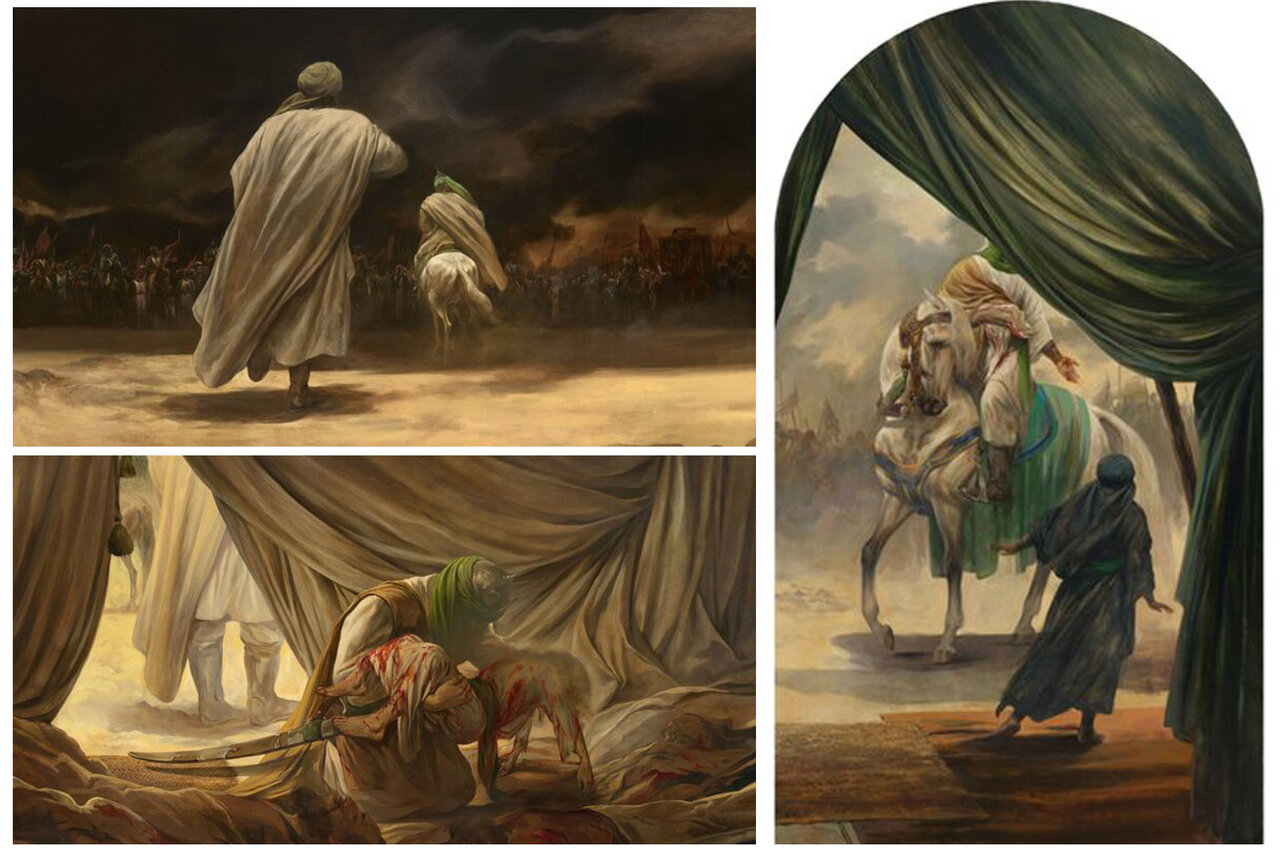Ruholamin unveils new Ashura paintings depicting key moments of mourning, sacrifice

TEHRAN – Iranian artist Hassan Ruholamin has unveiled three new paintings commemorating the events of Ashura, marking the martyrdom of Imam Hussein (AS), the third Imam and grandson of Prophet Muhammad (PBUH), along with his 72 loyal companions.
These artworks aim to deepen the emotional connection and reflection on the sacrifices made during this sacred occasion, Mehr reported on Sunday.
One of the artworks is dedicated to the farewell of Imam Hussein (AS) with his elder son, Ali Akbar (AS), the report added.
The painting captures the profound moment of farewell of Imam Hussein (AS) with Ali Akbar (AS). Accompanying the painting, Ruholamin composed a poetic verse that captures a segment of the mourning recitation for Ali Akbar (AS). Penned by Mohammad Sohrabi, the verse reads: “I ran behind you, lost my dignity and pride / Your gaze overlooks my tears, see my age and my plight.” This piece highlights the intense emotional suffering endured by Imam Hussein (AS) and his family.
Renowned for his mastery in depicting visual lamentations of the Battle of Karbala, Ruholamin also released another painting depicting of the mourning scene for Imam Hussein (AS)’s six-month-old son, Ali Asghar (AS).
Titled "Sanad" (Pledge), the painting commemorates the martyrdom of Ali Asghar (AS). This painting is illustrating the sorrowful scene of Imam Hussein (AS) holding his thirsty infant, Ali Asghar (AS), in his arms, emphasizing the innocence and tragedy of that moment.
Ruholamin explained this oil painting as: “The 'Sanad' portrays the return of Imam Hussein (AS) and Ali Asghar (AS) to the tents, with Sakina, Imam Hussein’s daughter, welcoming them— ‘Peace be upon the infant who was struck with grief...’” This scene reflects the profound grief and resilience of the family of the Prophet, emphasizing themes of sacrifice and love.
Another painting, titled "Amanat" (Trust), illustrates the return of the body of Imam Hussein’s nephew Qasim ibn Hasan (AS) by Imam Hussein (AS) to the tents on the Day of Ashura. This painting captures the somber moment of mourning, conveying the immense loss experienced by the family and followers of Imam Hussein (AS). Through these artworks, Ruholamin continues to honor the memory of Ashura, inspiring reflection on faith, sacrifice, and resilience.
Ruholamin, who is best known for his paintings on early Islamic historical events, has created a captivating collection of artworks dedicated to the theme of Ashura over the years.
One of the works of the collection is “Daddy” depicting the Imam in his final farewell to his three-year-old daughter Roqayyeh (SA).
The 110 X 130-centimeter oil painting shows the Imam embracing Roqayyeh before going to the battlefield while his horse, named “Zuljinah”, and the enemy forces can be seen in the background.
The collection also includes “The Sky Fell Down”, “The Farewell”, “After Abbas (AS)”, “Are You My Brother?”, “Monastery of the Monk” and “Beginning of Silence”.
“The Sky Fell Down”, featuring the last moments of the life of Imam Hussein (AS), is a highlight of the collection.
The painting depicts the Imam on his horse, severely injured by arrows, while the enemy is waiting to bring down the Imam.
Ruholamin spent nine months doing the painting, which was unveiled at the Tehran Museum of Contemporary Art in November 2018.
“Monastery of the Monk” is another artwork from his Ashura collection.
The painting depicts the meeting of a monk with Khawli ibn Yazid al-Asbahi, a member of Umar ibn Sad’s army, when he was taking the head of Imam Hussein (AS) to Yazid ibn Muawiya, the second caliph of the Umayyad dynasty, after the Ashura event.
Another work of artist on Ashura is a digital painting entitled “The Bravery of Hussein”, which portrays Imam Hussein (AS)’s courageous battle with the army of Yazid ibn Muawiya on the 10th day of the month of Muharram in the year 61 AH of the Islamic calendar (680 CE).
The painting depicts the remarkable battle of Imam Hussein (AS) on the day of Ashura amidst a sea of arrows, spears, and swords and this awe-inspiring display of courage has since become an enduring symbol of bravery.
The artist has also blended modern events and with stories from Islamic history in some of his works.
SAB/
Leave a Comment